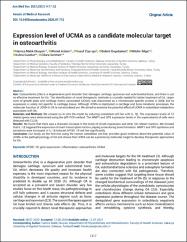| dc.contributor.author | Okuyan, H.M. | |
| dc.contributor.author | Arslan, Ahmet | |
| dc.contributor.author | Iğcı, Yusuf Ziya | |
| dc.contributor.author | Göğebakar, Bülent | |
| dc.contributor.author | Bilgiç, Nilüfer | |
| dc.contributor.author | Gündüz, Kübra | |
| dc.contributor.author | Sönmez, Dilara | |
| dc.date.accessioned | 2022-05-11T14:42:07Z | |
| dc.date.available | 2022-05-11T14:42:07Z | |
| dc.date.issued | 2021 | |
| dc.identifier.issn | 2636-7688 | |
| dc.identifier.issn | 2636-7688 | |
| dc.identifier.uri | https://doi.org/10.5455/annalsmedres.2020.07.712 | |
| dc.identifier.uri | https://app.trdizin.gov.tr/makale/TkRVNE5EUTBOQT09 | |
| dc.identifier.uri | https://hdl.handle.net/20.500.11776/9228 | |
| dc.description.abstract | Aim: Osteoarthritis (OA) is a degenerative joint disorder that damages cartilage, synovium and subchondral bone, and there is yet no effective treatment for OA. The identification of novel therapeutic methods is crucially needed for better treatment of OA. Upper zone of growth plate and cartilage matrix associated (UCMA) was discovered as a chondrocyte specific protein in 2008, but its expression is solely not specific to cartilage tissue. Although UCMA is implicated in cartilage and bone metabolic processes, the molecular function of UCMA in OA is not elucidated yet. We aimed to examine the potential effect of UCMA in osteoblast metabolism associated with OA. Materials and Methods: We created an in vitro OA model by inducing osteoblast cell line with IL-1?. The expression levels of 12 related genes were determined using the qRT-PCR method. The MMP1 and OPG expression levels in the supernatants of cells were detected with ELISA. Results: We found that there was a dramatic increase in the levels of UCMA expression and other OA-related markers. We showed that IL-1? triggered the expression of main transcription factors playing a role during bone formation. MMP1 and OPG synthesis and secretions were increased in IL-1? induced-hFOB1.19 cell line significantly. Conclusion: Our study, as the first one using the human osteoblast cell line, provides good evidence about the potential value of UCMA in the pathophysiology of OA and shows that UCMA can be a promising molecular target to develop therapeutic approaches for OA. | en_US |
| dc.language.iso | eng | en_US |
| dc.identifier.doi | 10.5455/annalsmedres.2020.07.712 | |
| dc.rights | info:eu-repo/semantics/openAccess | en_US |
| dc.title | Expression level of UCMA as a candidate molecular target in osteoarthritis | en_US |
| dc.type | other | en_US |
| dc.relation.ispartof | Annals of Medical Research | en_US |
| dc.department | Fakülteler, Tıp Fakültesi, Temel Tıp Bilimleri Bölümü, Tıbbi Biyoloji Ana Bilim Dalı | en_US |
| dc.identifier.volume | 28 | en_US |
| dc.identifier.issue | 7 | en_US |
| dc.identifier.startpage | 1417 | en_US |
| dc.identifier.endpage | 1422 | en_US |
| dc.institutionauthor | Arslan, Ahmet | |
| dc.identifier.trdizinid | TkRVNE5EUTBOQT09 | en_US |



















